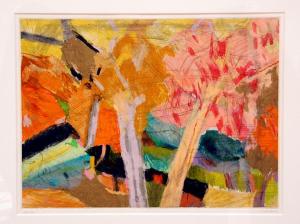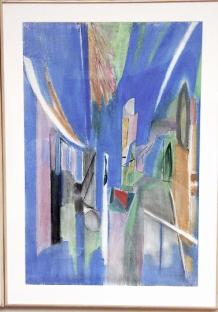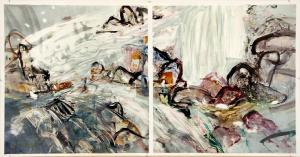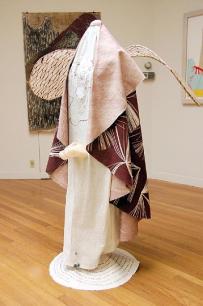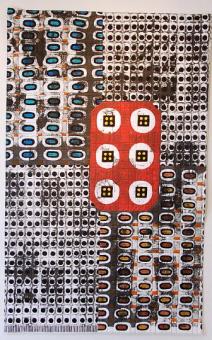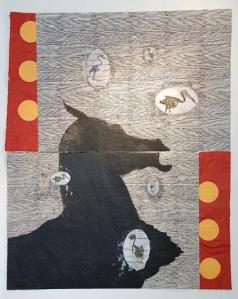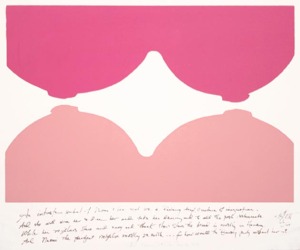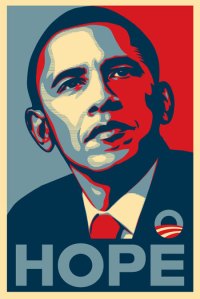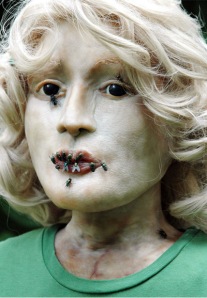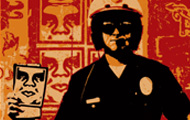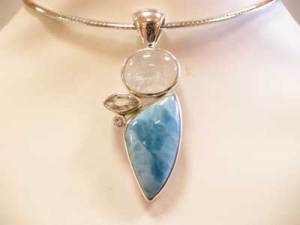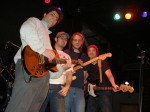Concord Art’s “Unique Print” show makes good impression
March 29, 2009
Much enjoyed the Concord Art Association’s New England Impressions III,” the Unique Print, March 21-May3, 2009.”
The show, presented on two floors in the CAA’s lovely colonial home at 37 Lexington Road in Concord Center, is a colorful collection of monotypes, monoprints and experimental prints composed of fabrics, hand quilting, stamping, sandpaper, and pastel, on wood, metal, ink and paper, and combinations of the above. In the words of curator Dorothy Thompson, the show is one in a series celebrating New England artists and printers “trying something new, breaking the rules.”
All of the works–with photos of each work and a video of the opening reception available at www.concordart.com, were stunning. My favorites included:
Roz Karal Ablo’s Interior Courtyard--a dramatic collage and pastel work in vibrant blues, mauves, with a little red and green thrown in. It seemed to embody the splitting of space into time, a la Duchamp, a rushing, perhaps, through what might be a structural, village courtyard composed of buildings, streets and sky– or, perhaps, an inner personal one.
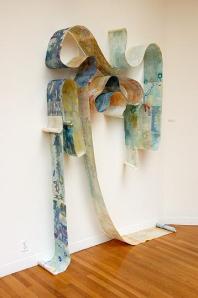
Randy Garber, Cognitive Dissonance
Randy Garber’s elegant Cognitive Dissonance, composed composed of hard and soft grand spit bite etching, wood cut transfer, monoprint on piano player scrolls.
Pastel colors, different on each side of the scrolls, are printed with abstract shapes, hands, gears, heads and other forms. The scrolls, though still, seem to undulate, mesmorizing the viewer as s/he comes to realize that words, presented in reverse order, actually make some sense. Appear may love where ing tell no there’s.
Jeanne Williamson, Orange Construction
Kate Millett at the Menard: More Pleasure than Oppression
March 29, 2009
From its title, “Oppression and Pleasure,” I expected the Pierre Menard Gallery’s current show of works by the feminist writer and artist Kate Millett to be heavy-duty, in-your-face and angry but was pleased to find, for the most part, colorful, simple brush-strokes that looked like Japanese characters, one to a painting. Perhaps I am slow, but it took me awhile to realize that each was a representation of female genitalia or other body parts.
I didn’t agree with one observer who found the work overly aggressive; to me, the paintings seemed lighthearted and whimsical–despite my interpretation of the title’s message that women’s sexuality can lead to both misery and joy.
I did wonder, however, if the two huge black and white close-up photographs of female sex organs (from which even the staunchest of men looked away) had been placed just over the food table to cut down on the demand for wine and chips.
The show, at 10 Arrow Street, in Cambridge, will be up through April 12.
AMH
New Cambridge Observer is a publication of the Harris Communications Group, of Cambridge, MA.
Shepard Fairey Revisited Again
February 22, 2009
Yesterday, I returned to the Shepard Fairey Exhibit at the ICA–this time, with visitors from out of town.
We were impressed with how prolific Fairey has been, with the precision and beauty of his images, and with his complex, ironic juxtaposition of past and present. (His backgrounds include a lot of old newspaper clippings and many references to art forms of the past).
In one work, Fairey selectively uses and amplifies portions of the American dollar bill–included an eye, which I’d never noticed until Jessie pointed it out; a man carrying a briefcase of money in one hand and flowers in the otherm and a woman, probably his wife, carrying a small missile in her arms. A caption reads: “No cents.”
This time, I studied the controversial Obama “Hope” poster, which, from across a large room DOES look like a colorized version of the copyrighted Associated Press photograph on which it was based.
But on closer inspection, in this version, it becomes clear that Fairey has greatly transformed the photo, which he uses in a provocative interchange with the colors, images, slogans, stencils, newspaper clippings and other elements typical of (and original to) his work.
Black “brushstrokes” highlighting Obama’s facial features serve as a frame for those elements, which in turn, provide the color, shading and chiseled shaping of Obama’s head.
As a result, the poster becomes a figure-ground study portraying many past events, conflicts and dilemmas that brought the US to the crises with which Obama is grappling, today.
The poster’s intertwining of past and present with the Obama image bring a definite irony to the slogan “Hope.” (One of the newspaper headlines in the background reads:”Congress Blames Hoover for Having No Sense of Humor).
Donna pointed out that the portrait is yet another example of Fairey’s overriding message: how the slogans, art and icons of advertising are used to move us to obey–whether the order be “buy”, “peace”, “shoot” or “hope.”
Fairey employs the same techniques for his portraits of Martin Luther King and other political leaders, musicians, artists and even one of a Campbell’s soup can– referencing and repeating the work of Andy Warhol, whose photography-based work, like Fairey’s, used advertising’s methods to comment on and exhibit the medium’s power.
Regarding Fairey’s recent arrest for illegally postering public property: Nancy (who happens to be a judge) and I wondered what controversy would arise if his work were posted as paid-for advertising–to sell what some might view as subversive, anti-establishment or propagandist ideas.
She later commented “Fairey seeks to reframe the constitutional debate so that artistic expression/speech is favored over commercial speech/intellectual property”.
Doree questioned whether Fairey’s work is political commentary or art. I’d have to say: it’s both.
Comments welcome!
AMH
New Cambridge Observer is a publication of the Harris Communications Group of Cambridge, MA.
Heads and Tales Review
February 18, 2009
If Heide Hatry’s provocative photographic show—Heads and Tales–at the Peirre Menard Gallery, (10 Arrow St. in Cambridge) is meant to shock: it does. In fact, for a few moments, it made me fear for the mental health of the artist, who has (beautifully–even lovingly) photographed her sculptures portraying female victims of violent death.
Hatry, who grew up in Germany and moved to New York City in 2003, sculpted life-sized female mannequins from clay and covered them with untreated pigskin (a cold wet sample of which is available in the gallery with the notice: “please touch”). She added raw meat for the lips and fresh pig eyes—and in some cases, flies, safety pins, and other props—creating, according to the gallery writeup, “the illusion of life where there is none”.
Hatry then photographed the mannequins—some enlarged to 20”x 30”, others more life-size, at 12” x 18”.
Viewed from afar, the photographs appear lifelike, but close up, you realize the subjects are constructs—adding physical and intellectual layers to the artist’s statements on the horrifying situations faced by many women—and on photography’s role in bringing the inanimate to life.
Hatry’s “views” are further emphasized by accompanying tales about the “women’s” lives (and deaths) as imagined by 27 writers—some of them well known feminists.
The show is well-conceived and displayed, which makes its subject matter all the more disturbing.
The exhibit, which opened Feb 13, 2009, will run through March 15. It corresponds with the release of Hatry’s book, Heads and Tales, and with readings, book signings and the premiere of a play.
AMH
New Cambridge Observer is a publication of the Harris Communications Group of Cambridge, MA.
Fairey bruhaha enhances coffers–especially lawyers’.
February 9, 2009
After spending Friday night in jail, today, street artist Shepard Fairey was arraigned today in Boston for allegedly pasting “Andre The Giant” graffiti near an entrance to the Massachusetts Turnpike and the Boston University bridge across the Charles River–nine years ago. Fairey also countersued the Associated Press–who sued him last week for basing his now famous Obama “Hope” poster on a copyrighted AP photograph.
Having seen the poster at Fairey’s opening at the Institute of Contemporary Art last week, I agree with him that the poster significantly transformed the photo (actually, I think, improved it and turned it into art) and, thus, does not violate copyright law. What’s more, Fairey has not sold the work–and, while he might have enhanced (and now harmed) his reputation by distributing it for free, he did not directly use it for financial gain.
The “tagging” of public places and ensuing arrests are part and parcel of Fairey’s art. He and his work present a provocative and humorous challenge to authority; the bruhaha publicizes Fairey’s image and images, delights upstarts, and, I suppose, infuriates the powers that be. It also promises to enlarge the coffers of Fairey,of the ICA (whose director, Jill Medvedow recently sent out an email of support on Fairey’s behalf) and, especially, of the lawyers.
Still, with the world going to rack and ruin, it’s nice to know that some people are making money– and fun to have a new set of old issues to focus on.
AMH
New Cambridge Observer is a publication of the Harris Communications Group of Cambridge, MA.
Review: Shepard Fairey Restrospective, ICA Boston
February 5, 2009
Kudos to Boston’s Institute for Contemporary Art for mounting a spectacular 20-year restrospective of Shepard Fairey’s work–which opened for members on Feb. 4, 2009.
Entitled “Supply and Demand,” the show, which runs through August 16, 2009, includes some 200 stickers, posters, portraits, and murals, including the now iconic Barack Obama “Hope” poster which has found its way all over the world.
The show traces Fairy’s work to the 1980s when, as a teenager in Charleston, South Carolina, he was attracted to counter-cultures like skateboarding and punk rock–and their stickers–and began making his own.
As a student at the Rhode Island School of Design in 1988, Fairey instructed a friend in making a paper cut stencil using an image of Andre the Giant, who a popular figure in the World Wrestling Federation, am ICA handout explains. The two then paired the face with the phrase “Andre the Giant has a posse,” and over the next six years, produced more than a million hand-printed and cut stickers, which Fairey sent to friends who posted them all over the US.
(On a huge campaign billboard, he also used one to cover the face of then-Providence mayor Buddy Cianci, who says sheepishly in an accompanying video that this disturbed him because it was defacing property. It’s all the funnier in hindsight, knowing that Cianci was later jailed on corruption charges).
Toward the end of the 1990s, Fairey started to challenge what the ICA calls the “corporate advertising machine…He asks us to consider whether the so-called ‘public space’ is really public.
“Most advertising takes an ‘in your face’ approach to sell or influence consumers. Fairey’s Obey giant campaign–which features the word “obey” and other slogans [on a variety of images ]sells nothing but its mysterious imagery, ambiguity and underground appeal has made passers-by worldwide question the visual noise that crowds our streets”–as well as the insidious advertising messages used to command us.
One large room features portraits–some of which incorporate the “obey” command. One print portrays George W. Bush as a vampire, with blood running out of his mouth. Other portraits feature musicians, guerilla leaders, gang members, Muslim women, and additional political leaders.
A highlight is Fairey’s iconic “Hope” portrait of Barack Obama, which “has spread like a virus on TV, in print and online, on t-shirts and buttons, and guerilla-style on streets all over the globe.”
The poster seems particularly poignant with Obama, now in his third week as President, facing not only a terrible economic situation and two wars, but also the disintegration of a seemingly promising leadership team whose members betrayed him and us for personal greed.
The exhibit, co-curated by guest curator Pedro Alonzo and Emily Moore Bouillet, former assistant curator at the ICA, and sponsored by Levi-Strauss culminates with a set of four stunning, intricately designed, murals.
Commissioned by the ICA, the murals, along with the other components and the exhibit as a whole are inspirational.
Not only do they each convey provocative messages about individuals’ relationship to power and commerce, but they embody and communicate an individual’s ability to follow his creative instincts and passion to achieve artistic and, ironically, commercial success.
*
Having arrived on time for the opening, I didn’t have to wait in line–but in a lovely wine reception on the second floor, was told that people who got there early had to stand outside in the cold until the official opening time. in leaving, at around 8 PM, I had to cut around long, winding lines of people in the lobby who were waiting to sign in.
My only beef was the lack of beef…the wine was fine, but my companion, Mark H. and I would have appreciated a few chips to go along with it. Next time, I’ll definitely arrive on time–and eat before I go.
AMH
New Cambridge Observer is a publication of the Harris Communications Group of Cambridge, MA.
Treasures Over Time: Gems and Geology in Salem
February 1, 2009
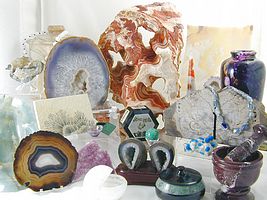 Yesterday was sparkling cold and sunny so Sheila and I decided to drive up to Salem to visit Treasures Over Time, one of the loveliest shops I’ve ever been in–and for someone whose favorite sport is shopping, that’s saying a lot.
Yesterday was sparkling cold and sunny so Sheila and I decided to drive up to Salem to visit Treasures Over Time, one of the loveliest shops I’ve ever been in–and for someone whose favorite sport is shopping, that’s saying a lot.
Founded by proprietors Nestor and Sivan Sergott, the shop, recently relocated to 139 Washington Street, features gems and geology: hand chosen, hand made decorative, home and office and jewelry items made by international artists and artisans from mineral materials all over the world.
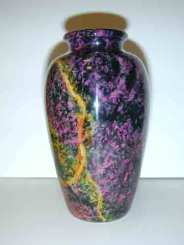
Serpentine Vase
Some of my favorite pieces are made of serpentine–rock sculpted into useful objects, then fired at high temperatures, which brings out their colors.
We also loved the jewelry–and the
fantastic collection of fossils, and rough mineral specimens, all beautifully displayed in the two-room store.
Full disclosure, Sivan’s grandmother and mine were sisters; one reason for the trip was to discuss a show of photographs of rock formations I took on the South Coast of Australia–which, we agreed will happen sometime this Spring.
Anita
New Cambridge Observer is a publication of the Harris Communications Group, of Cambridge, MA.
Obama Celebration-poetry and pictures
January 31, 2009
Watching the Obama inauguration ceremonies on TV, I felt disappointed by poet Elizabeth Alexander’s “Praise Song for the Day”…but agree with Martha Swartz of Philadelphia, who points out in her email newsletter that that the poem works better read than heard. It’s included below.
Martha, a lawyer who regularly sends out political commentary, also offers links to photos of the inauguration: http://www.boston.com/bigpicture/2009/01/the_inauguration_of_president.html.
Inauguration photos by Wilmington, DE photographer Kathe Kahn Morse are posted at http://gallery.me.com/kathemorse#100008 .\
If you’d like me to link to your photos, commentary or anything else regarding the inauguration…or actually…anything else at all…please leave a comment to let me know!
Anita
Here’s the poem:
PRAISE SONG FOR THE DAY
by Elizabeth Alexander
Each day we go about our business, walking past each other, catching each others’ eyes or not, about to speak or speaking. All about us is noise. All about us is noise and bramble, thorn and din, each one of our ancestors on our tongues. Someone is stitching up a hem, darning a hole in a uniform, patching a tire, repairing the things in need of repair. Someone is trying to make music somewhere with a pair of wooden spoons on an oil drum with cello, boom box, harmonica, voice. A woman and her son wait for the bus. A farmer considers the changing sky; A teacher says, “Take out your pencils. Begin.” We encounter each other in words, words spiny or smooth, whispered or declaimed; words to consider, reconsider. We cross dirt roads and highways that mark the will of someone and then others who said, “I need to see what’s on the other side; I know there’s something better down the road.” We need to find a place where we are safe; We walk into that which we cannot yet see. Say it plain, that many have died for this day. Sing the names of the dead who brought us here, who laid the train tracks, raised the bridges, picked the cotton and the lettuce, built brick by brick the glittering edifices they would then keep clean and work inside of. Praise song for struggle; praise song for the day. Praise song for every hand-lettered sign; The figuring it out at kitchen tables. Some live by “Love thy neighbor as thy self.” Others by first do no harm, or take no more than you need. What if the mightiest word is love, love beyond marital, filial, national. Love that casts a widening pool of light. Love with no need to preempt grievance. In today’s sharp sparkle, this winter air, anything can be made, any sentence begun. On the brink, on the brim, on the cusp — praise song for walking forward in that light.
New Cambridge Observer is a publication of the Harris Communications Group of Cambridge, MA.
Between Blockbusters at the ICA
January 26, 2009
On a freezing cold January afternoon, my companion and I decided on a quick getaway to Boston’s beautiful new Institute of Contemporary Art.
With Tara Donovan’s fantastical landscapes (composed of everyday objects like paper cups, toothpicks and drinking straws) now dismantled and a show of street-artist (and Obama portraitist) Shepard Fairey yet to launch, my companion and I were able to focus on highlights of previous exhibitions, the work of emerging artists chosen as finalists the ICA’s 2008 Foster Prize, the wonderful late afternoon light, Peet’s coffee ($1.80) and huge brownies ($3.00) in the ICA cafe, which overlooks the water.
My companion, a college student just back from a semester in Israel, was particularly taken with Rania Matar’s photographs showing moments of stability in wartorn Lebanon: an elderly woman in a business suit eading the same newspaper as black-dressed muslim women, children playing amidst the rubble, and a stately home, seen through building ruins.
I liked having the quiet time to ponder acquisitions from previous shows: Paul Chan’s digital animation of shadows, and Roe Ethridge’s photograph of Countyline Meadowmere Park, in Long Island, New York.
A favorite oddity–by the French-born artist Kader Attia– was what appeared to be a relaxing video of ice cube slowly melting and shifting against a brick backdrop …until closer inspection (and the writeup) revealed that we were watching oil turn sugar cubes into black, oozing goop–in a statement on global environmental decay.
